A Retrospective, 1948-2003
Catalog illustrations with commentaries...
Catalog nos.
78-116
Click for
Catalog
nos. 1-26.
Catalog
nos. 30-54
Catalog
nos. 55-63
Catalog
nos. 65-77
Catalog
nos. 119-137
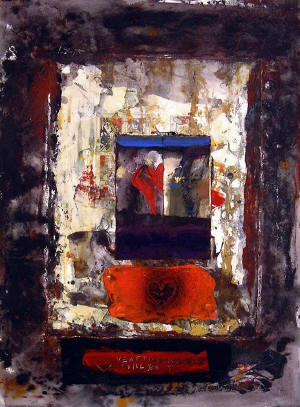
|
Cat. no. 78.
Venetian Hearts Still Beat. February 1993.
Acrylic collage on
paper, 44¾ x 33¼ in.
A few
months after Ashes with Poppy and near the vernal equinox of
1992, I began to court Stephanie Dudek, and we were married in
December 1992. I resigned my job as Vice President and Dean of
Academic Affairs at SFAI on my 65th birthday in June of
1992, to continue to teach one semester each year at the Institute. I
quit watercolor and gouache as being too thin and started to use
acrylic in ever thicker and looser ways because I wanted a materiality
in my art to match the awakening roar of sensuality in my body. There
was going to be a Valentines show at the Pier 23 Restaurant on the San
Francisco waterfront. I made a lot of Valentines to carry me beyond
the dead ashes of my old heart and to show the pounding throbbing life
of my new one.
|
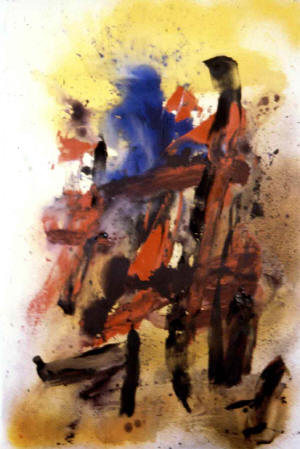
|
Cat. no. 79
Tintoretto: A Centurion’s Flag I. May 16, 1994.
Acrylic on
paper, 68 x 44 in.
When
I was making computer art/paintings to keep and give away in the late
1980s, I had made a series of Lessons from the Masters, little
11 x 8 ½ inch pieces about artists who have mattered to me. One
artist was Tintoretto, whose Road to Golgotha in the Scuola San
Rocco in Venice I had seen and always remembered from a Life
magazine Christmas edition when I was a child. I had written in the
Lessons that “Tintoretto teaches us how to paint the ascent of
Golgotha against a darkening sky… he teaches of the nobility of those
strong men who led Christ to His resurrection, strong men who knew
already in their own lives that dark blood burden of flesh transfixed
in the light of eternity.” My own flesh was roaring with life; like
Christ, I had been resurrected.
|

|
Cat. no. 81. Titian Diptych, left side (after
Sacred and Profane Love). April 22, 1994. Acrylic on paper, 68 x
88 in.
Collection Stephanie Dudek, Montreal, Canada.
Titian’s Sacred and
Profane Love has always been of enormous importance to me because
it shows the three phases of Eros. On the left, he painted a
sumptuously clothed woman before a castle as his vision of the
domestic eros that I had made in the 1960’s as the Western Homestead.
On the right, he painted a nude woman holding a flame in the sky as
the transcendent eros that I have always sought to live in the
absolutes of the heart. And in the center he made a little boy
splashing water in an old sarcophagus—the unending generation of life
coming out of death that is our true immortality. With the new and
roaring eros in my veins (that same little boy splashing water at the
center of Titian’s painting), I made this homage to the domestic and
transcendent sides of Titian’s painting. The splashing eros at the
invisible center I did not paint is the fountain of my life itself.
|
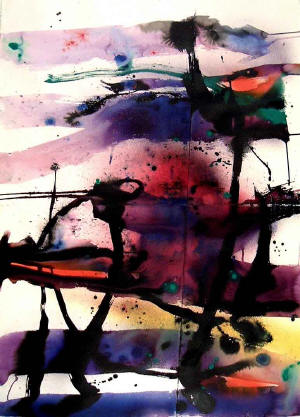
|
Cat. no. 82. Ganges Dawn II. January 20,
1997.
Acrylic on paper, 60 x 44 in.
Collection Paul Mills, Santa Barbara. CA.
In
1996, I received an SFAI faculty development grant for travel to
India—I was teaching Asian art and needed the kinds of slides that
come from being there, not the kind of art history slides that
document but have no visual or emotional experience. Of course, one
of the things tourists always do in India is Varanasi and the Ganges
and the Burning Ghats. We went there. I photographed the boatloads
of picnickers scattering flowers on the water, but I did not
photograph the sacred burning of the dead nor the men who scrambled in
the mud and ashes looking for gold teeth. I did photograph the dawn,
and I made this painting—almost the last of my “large paintings” to
date—to evoke and fulfill a dawn on India’s sacred river of life.
|
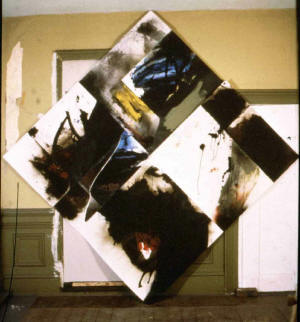
|
Cat. no. 83. Shanghai I.
January 4, 1994.
Acrylic on paper, four parts, each 63 x 63 in., total 126 x 126
in.
Collection Oakland Museum.
The
awakening roar of sensuality in me demanded larger and ever larger
scale, not for the fantasy of “glory and majesty” that had been so
important a motivation for the large acrylics of the 1960s, but for
the expression of the enormous expansion of my libido—yes, call it
that—my sensual, erotic life force. I took the sensations of the
Shanghai waterfront—the Huang Pu river with all its ships coming and
going and rusting and rotting—as I had experienced it in the afternoon
and night of the summer of 1992. I made those sensations of Shanghai
big enough to engulf the viewer in the way that my eros was engulfing
me.
|
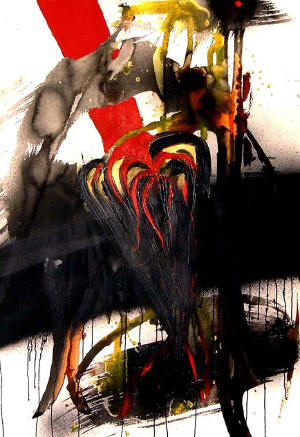
|
Cat. no. 92. #2,
May 2000, Gold Heart with Ray, State II.
Acrylic on paper, 44 x
30 in.
Sometime in late 1999 or early 2000, I realized that what I have
always done in my messy studio is what the alchemists always did in
their smoky laboratories: take the dross of life you can’t figure out
what to do with (the alchemists’ nigredo) and cook it no matter
how long until it turns into gold (the alchemists’ aurum nostrum).
For a long time, that had been for me the transformation of the raw
power of my sexuality into the even more powerful and absolute
commitments of my heart—and that is what this painting is about (as I
wrote in my studio notes, “Send out from the heart a ray of living
light”). Along with my realization that “alchemy as transformation”
is the primary purpose of my art, there came the realization that my
art is not for the “glory and majesty” of my ego but for the daily
worship of the glory and majesty of life itself.
|
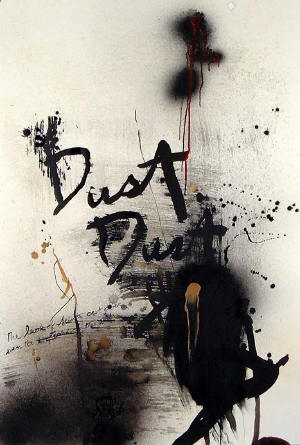
|
Cat. no. 101. #7,
August 2001, Untitled with Dust and Evening Star.
Acrylic on paper, 44 x
30.
And so with the
understanding that the purpose of my art is not to get into
Documenta—but I sure would like to—but to show to myself and to seek
by painting to understand the greatest powers (the “glory and
majesty”) of my own life, I decided for a time (it’s been now three
years and hundreds of paintings) to work only in acrylic and only on
paper that is 44 x 30 inches… a size just a little awkwardly big for
my own drawing arm to reach the top and for anyone else to hang above
their living room couch. The great powers that have ruled my life
have been and are the glory and majesty—and terror—of sex and
procreation, of love and loss and death, of time and the only eternity
we have that is NOW. In this painting I was given to know the dust of
life’s end and the evening star of life’s promise of tomorrow.
|
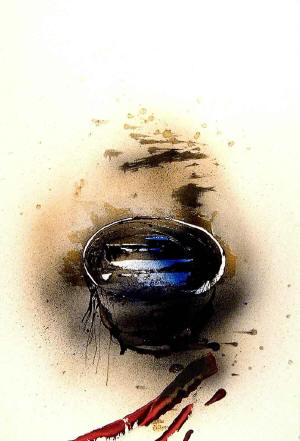
|
Cat. no. 113. #13,
August 2002, The Bowl of Stars.
Acrylic on paper, 44 x 30
in.
In
the mid 1950s, I made a painting of my male sexuality as a flower of
blood torn from my body and thrown into the gutter. It was as
horrible and graphic an image as I could make, and I hid it from my
family and myself in a dark unexcavated corner of our basement until
long after the family was grown and moved far away. When at last I
got the painting out in preparation for this exhibition, the damp had
rotted the paint, and worms had eaten the canvas. I had made that
image in the 1950s as the curse and torment of my masculinity, and I
had also made an image of the feminine that I hoped would save me (and
the feminine—marriage—did save me). The feminine image was a bowl of
blue water reflecting the stars. In the summer of 2002, I returned to
those images, the blood flower now no longer the terror it had been,
and this bowl of stars for what it has been all my life.
|
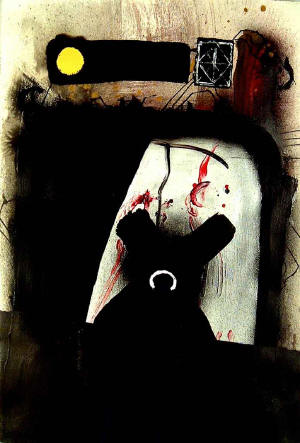
|
Cat. no. 115. #2,
January 2003, Untitled.
Acrylic on paper, 44 x 30 in.
Beginning in early 2002, I worked on this painting for months. When
it came to resolution early this year, it was the sun—that yellow
spot—at the core of my manhood that did it, along with the realization
that, as I wrote in my studio notes, “I cannot say it, I cannot say
it—those who know, don’t talk; those who talk, don’t know. Painting
and poetry, painting and poetry. There are no words to say what
painting and poetry—and this painting—are for me.”
|
 |
Cat. no. 116. #1,
February 2003, Untitled.
Yes, my painting is about my fears of the glory and the majesty of
life, and that surely includes death. And so I made on this
paper a ground color of age and dark and wrote the words I heard.
The words looked dumb, so I made my handprints over them in white and
red for spirit and flesh, and that looked even dumber, so I
covered them with a black square in a "dynamic symmetry" that I had
learned when thirty years ago I sought a pre-established harmony.
I put my handprint back in the gold that is forever, but it was too
thick and sticky in the wet black. I scraped it out and put it
back and saw that what the painting showed me was my tomb. The
painting was empty at the top where it is always so had for me to
reach, and I put a star there to reach for from the tomb... and then I
saw the immortal river of the fire and blood of life, and I put that
between the tomb and the star. |
Click for
Catalog
nos. 1-26.
Catalog
nos. 30-54
Catalog
nos. 55-63
Catalog
nos. 65-77
Catalog
nos. 78-115
Catalog
nos. 119-137
|